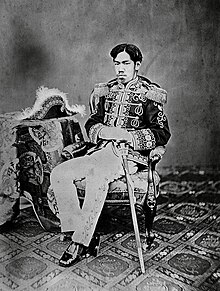
Back Meiji Afrikaans الإمبراطور ميجي Arabic الامبراطور ميجى ARZ Meiji Tennō AST Meyci Azerbaijani Император Мэйдзи Bashkir Імператар Мэйдзі Byelorussian Мейджи Bulgarian সম্রাট মেইজি Bengali/Bangla Emperador Meiji Catalan
| Emperor Meiji 明治天皇 | |||||||||
|---|---|---|---|---|---|---|---|---|---|
 Portrait by Uchida Kuichi, 1873 | |||||||||
| Emperor of Japan | |||||||||
| Reign | 30 January 1867 – 30 July 1912 | ||||||||
| Enthronement | 13 February 1867 | ||||||||
| Predecessor | Kōmei | ||||||||
| Successor | Taishō | ||||||||
| Shōgun | Tokugawa Yoshinobu (1866–1868) | ||||||||
| Daijō-daijin | Sanjō Sanetomi (1871–1885) | ||||||||
| Born | Mutsuhito, Prince Sachi (祐宮睦仁親王) 3 November 1852 Kyoto Gyoen National Garden, Kyoto, Yamashiro Province, Tokugawa shogunate | ||||||||
| Died | 30 July 1912 (aged 59) Meiji Palace, Tokyo City, Tokyo Prefecture, Empire of Japan | ||||||||
| Burial | 13 September 1912 | ||||||||
| Spouse | |||||||||
| Issue among others... | |||||||||
| |||||||||
| House | Imperial House of Japan | ||||||||
| Father | Emperor Kōmei | ||||||||
| Mother | Nakayama Yoshiko | ||||||||
| Religion | Shinto | ||||||||
| Signature | |||||||||
Mutsuhito (Japanese: 睦仁, 3 November 1852 – 30 July 1912), posthumously honored as Emperor Meiji[a] (明治天皇, Meiji-tennō), was the 122nd emperor of Japan, according to the traditional order of succession. Reigning from 1867 to his death, he was the first monarch of the Empire of Japan and presided over the Meiji era. His reign is associated with the Meiji Restoration, a series of rapid changes that witnessed Japan's transformation from an isolationist, feudal state to an industrialized world power.
At the time of Emperor Meiji's birth in 1852, Japan was a feudal pre-industrial country dominated by the isolationist Tokugawa shogunate and the daimyō subject to it, who ruled over the country's 270 decentralized domains.[4] By the time of his death, Japan had undergone an extensive political, economic, and social revolution and emerged as one of the great powers on the world stage. The New York Times summarized this transformation at the emperor's funeral in 1912: "the contrast between that which preceded the funeral car and that which followed it was striking indeed. Before it went old Japan; after it came new Japan."[5]
- ^ On 1 May 1865 (the seventh day of the fourth month in the second year of Genji), Emperor Kōmei changed the era name from Genji to Keiō. Although Emperor Kōmei died on 30 January 1867 (the 25th day of the 12th month in the second year of Keiō), and Emperor Meiji ascended to the throne on 13 February 1867 (the ninth day of the first month in the third year of Keiō), Keiō still continued until 23 October 1868 (the eighth day of the ninth month in the fourth year of Keiō), when Emperor Meiji changed the era name from Keiō to Meiji.
- ^ Keene 2002, p. 706.
- ^ "Explainer - Japan new imperial era name, Reiwa: Origins, Selection, Meaning". Reuters. 1 April 2019. Retrieved 2 February 2023.
- ^ Keene 2002, p. 200.
- ^ "The Funeral Ceremonies of Meiji Tenno", reprinted from the Japan Advertiser Article 8—No Title], New York Times. 13 October 1912.
Cite error: There are <ref group=lower-alpha> tags or {{efn}} templates on this page, but the references will not show without a {{reflist|group=lower-alpha}} template or {{notelist}} template (see the help page).
© MMXXIII Rich X Search. We shall prevail. All rights reserved. Rich X Search